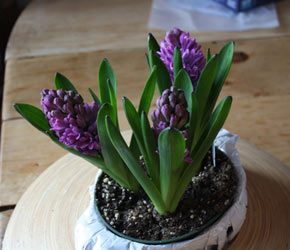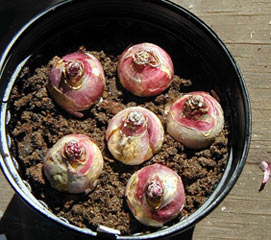Forcing hyacinths at home
Hyacinth is quite suitable not only for cultivation in garden conditions, but also for use as a perennial home plant. There are six main groups of hyacinths by color: white, red, pink, yellow-orange, blue-blue and purple-lilac. Within each species, new shades of flowers of regular and terry varieties are constantly being developed. In order to achieve flowering hyacinth at home, you need to make some effort. The process of preparing the bulb for flowering is called “distillation”.

For home planting, choose bulbs that have a diameter of at least 5 cm (for planting in open ground, take smaller bulbs). They should be dense, free from mechanical damage and signs of illness. Shop planting material must already be prepared for planting accordingly. If you took a young bulb from a dug plant, special conditions must be created for it for proper ripening. This is a very important moment that ensures the flowering of the plant in the next season. Tubers are usually dug up in June, after which it is recommended to dry them at a temperature of 30 ° C. In the next two weeks, the storage temperature of the bulbs is reduced to 25 ° C, then, until planting, they are kept at a temperature of no more than 17 ° C. You can plant a hyacinth in a pot whenever you want - usually, flower growers try to guess so that the period of its flowering coincides with some holiday. It takes about 3-4 months from planting to the appearance of flowers.
Before planting the bulbs in the ground, it is advisable to treat them with disinfectants for the prevention of various diseases. The soil for hyacinth should not be acidic. You can use a ready-made soil mixture, or you can prepare the substrate yourself by mixing compost, sod and leafy soil. The soil is poured onto the drainage layer, and sprinkled with sand on top. When planting, the bulbs are slightly pressed down, while the upper part of the tubers should remain on the ground. The next stage of forcing hyacinth is an obligatory rest period. It is necessary to keep the tubers in a dark place for 2 - 2.5 months at a temperature not higher than 5 - 7 ° C. Higher temperatures during this period can cause the lack of flowering or deformation of flowers. The soil in the pot should always be moist. During the dormant period, the rooting of hyacinth bulbs occurs.

As soon as the rooting process is completed successfully, the plant will have young shoots. It is recommended to move the pot home when the sprouts reach 2.5 cm. Earlier transfer contributes to poor growth and poor hyacinth flowering at home. Too late exit from the dormant period is also undesirable - the plant will give abundant foliage to the detriment of flowering. During the first month of growth, it is necessary to provide the plant with a temperature of 10 to 12 ° C in a well-lit room. During the budding period, you can move the flower to a permanent, warmer (up to 20 ° C) place, with good lighting, protected from heating appliances and drafts. Water your homemade hyacinth so that the soil in the pot remains moist. In this case, it is necessary to ensure that the water does not flood the leaves and the bulb. For uniform development of a flower, it is necessary from time to time to rotate it relative to the light source. It is good if additional evening lighting will be organized for the hyacinth. Lack of light and moisture contributes to poor growth and yellowing of leaves, and can inhibit flowering. Abundant and improper watering can lead to rotting of the bulb and premature fall of the buds.
At home, hyacinth can be grown not only in a pot with an earthen mixture, but also simply in water. To do this, instead of planting in the ground, the bulb is placed in purified water so that the bottom of the tuber touches the water. The container should be narrow enough so that the bulb does not float, but is fixed to the surface. Before the water stage, the bulb must go through all the preparation stages described above.Containers with hyacinth tubers are wrapped in thick paper and placed in a dark, cool place, providing a dormant period. Water should be added periodically. After the roots and shoots appear, it is recommended to gradually add nutrients to the water.

After the end of flowering, the faded stems are cut off and wait for the complete withering away of the ground part of the plant. During this period, the hyacinth continues to be watered and fed so that the bulb grows up and forms children. After the leaves die off, the bulb is dug up and dried. Large daughter tubers are separated, small, difficult to separate, it is better to leave until the next season. Mother bulbs are no longer suitable for re-forcing, they can be planted in an open area, where they will bloom after a year.








